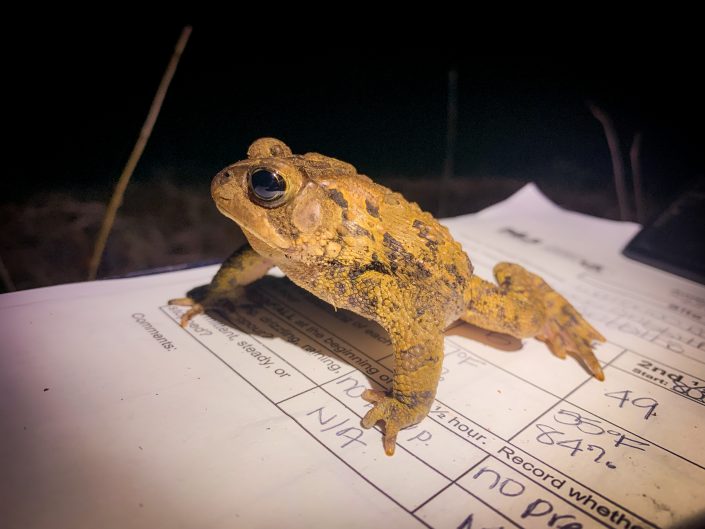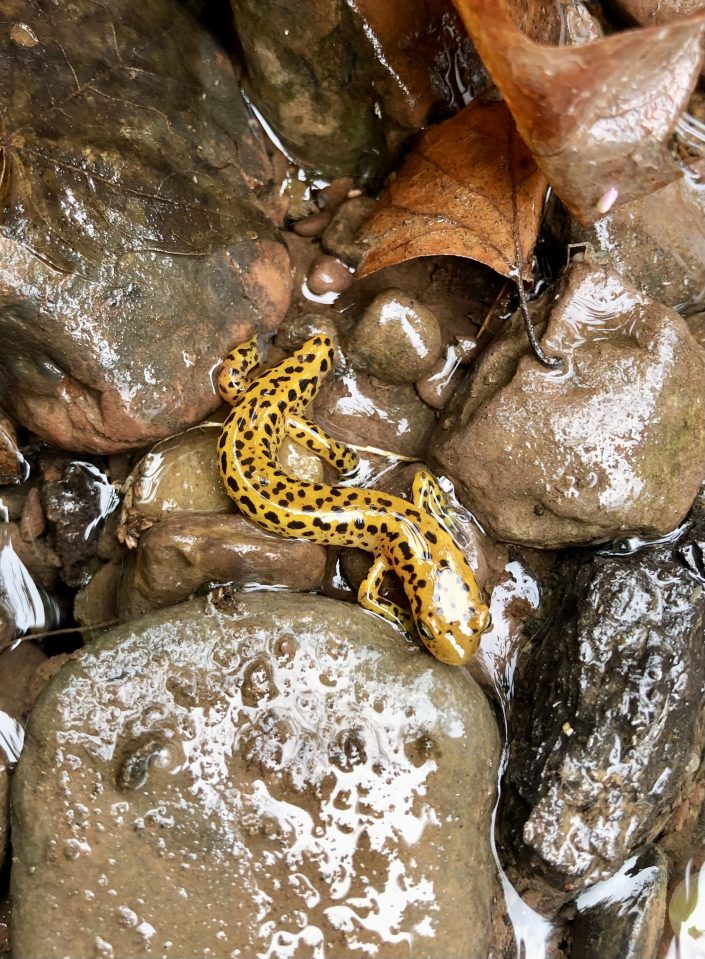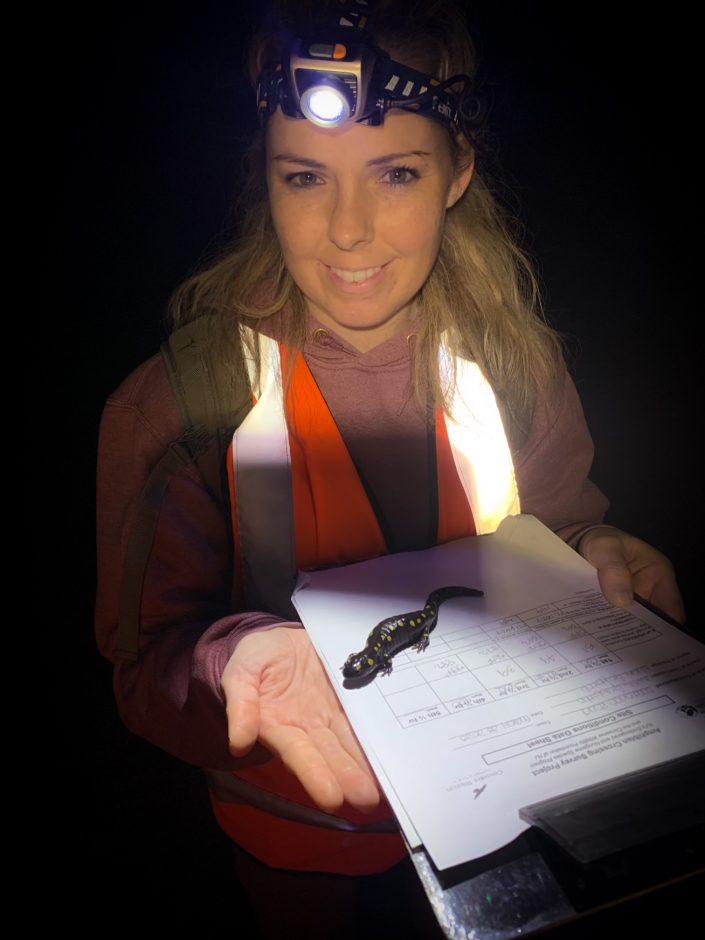Happy Amphibian Week!
by Christine Healy, Wildlife Biologist
If you follow us or any other wildlife organizations on social media, you may have noticed that our posts these last few days have been inundated with amphibians. It may seem like odd timing, given that our early breeders (wood frogs, spotted, and Jefferson salamanders) completed their crossroad migration last month. But the reason is simple – it’s Amphibian Week!

Globally, amphibians are disappearing faster than any other vertebrate group. The International Union for the Conservation of Nature (IUCN) estimates that 41% of amphibian species categorized for their Red List are currently facing extinction. That estimate is likely conservative, given that these creatures are often small and difficult to survey, rendering many species data deficient. This is concerning from multiple perspectives. From an ethical standpoint, we don’t want any wildlife to go extinct except maybe, in my extremely biased opinion, certain types of ticks… (I began my career as a moose technician and saw firsthand the terrible consequences that winter ticks have on these behemoths). Beyond that though, amphibians are tasked with a lot of responsibilities and carry out their work efficiently and without complaint. The list is inexhaustive but here are a few things that amphibians are doing for us and our planet as we speak: filtering water, sequestering carbon, eating pests (like mosquitos!), serving as prey for countless predators, helping researchers study regeneration (with hopeful applications to the future of organ transplants), aerating the soil in your garden, indicating where water sources have been contaminated by pollutants, and giving everyone who meets them a reason to smile.

If you haven’t volunteered for our Amphibian Crossing Project or spent time flipping logs along hiking trails, you might not think about these animals at all. I get that. As stated before, my background was actually in mammalogy before I came to CWF. Maybe because they remind us of our beloved pets at home or maybe because we’re part of the club, mammals are exceedingly easy to love. Birds too, with their flashy plumage and acrobatics are also quite captivating, especially given New Jersey’s location along the Atlantic Flyway. They get recognition, while amphibians get overlooked. Consider this though- when you add together the % of Red Listed bird and mammal species, that value is still lower than the (conservative) 41% estimate for amphibians…
I was 27 years old the first time I met a salamander. I was helping my predecessor, Allegra, out with a crossing. It was a Jefferson salamander and then, shortly after, she showed me an injured spotted. Up until that point, I still thought amphibians were a fun deviation from mammal work that I would surely be returning to. That experience changed things though. Amphibians became beautiful and exciting to me. I’ve spent the last three years learning as much as I can about them and look forward to continued study into the foreseeable future.

If you give yourself the opportunity to get curious about these little guys, you might discover, as I did, that they are pretty special. And that’s the purpose behind our Amphibian Week celebration. Spend some time delving into the world of amphibians through our behind-the-scenes videos from the field. Spread the knowledge you acquire to friends and family by playing our jeopardy game, designed by CWF intern, Connor Zrinko. Let your kids engage with all the colors and patterns exhibited by our native salamanders through the adorable coloring book page, illustrated by the talented Lizzy Doyle. Among other activities, all available for free, through our Google Drive (https://drive.google.com/drive/u/0/folders/1YcQBl9ElUPZrnB2h9QBIHRqVX7tk_O_Q?fbclid=IwAR3WynVfD3N5i_viThSh7_P0993RviVB3iD-PybiQbqoT_PkzkHRdQfbPgc) .
Amphibians are threatened by many things, including human apathy.
You can help by:
- Participating in Amphibian Week! If you submit a completed Scavenger Hunt, available in our Google Drive, to me (Christine.healy@conservewildlifenj.org) by the end of the week, you could win a prize!
- Creating habitat in your yard by leaving a few leaf or brush piles for them to seek refuge in.
- Looking – but not touching (unless you are helping one across a road). Amphibians have very sensitive skin and the presence of chemical sanitizers, lotions, and oils on your hands can harm them.
- Sticking to designated trails when hiking or ATV’ing.
- Being on the lookout for migrators if driving on rainy spring evenings near freshwater.
- Donating to help our Amphibian initiatives! We do more than just the Amphibian Crossing Project and these efforts are severely underfunded. You can donate by:
- Purchasing a pair of our limited-edition marbled salamander earrings: https://wildlifenj.square.site/product/-limited-edition-marbled-salamander-earrings/73?cp=true&sa=true&sbp=true&q=false&fbclid=IwAR2hK6o11ZXJmuDOWeBo_-BntaHKvym-iYxP01Q4WT7bIB2snAe2Qh9w0ho
- Recognizing yourself or a loved one as an “Amphibian Ally” or an “Amphibian Advocate”: https://wildlifenj.square.site/product/amphibian-ally-advocate-certificate/74?cp=true&sa=true&sbp=false&q=false
- Giving a gift to benefit amphibians through: http://www.conservewildlifenj.org/getinvolved/donate/
Thank you and Happy Amphibian Week!
Discover more from Conserve Wildlife Foundation of NJ
Subscribe to get the latest posts sent to your email.